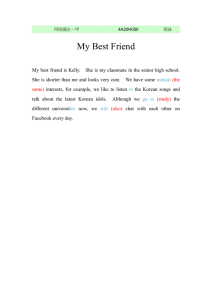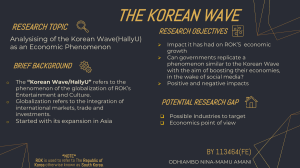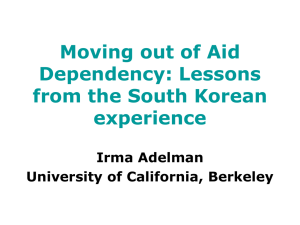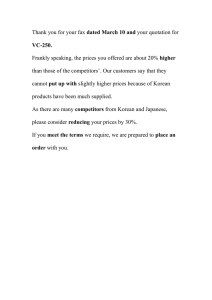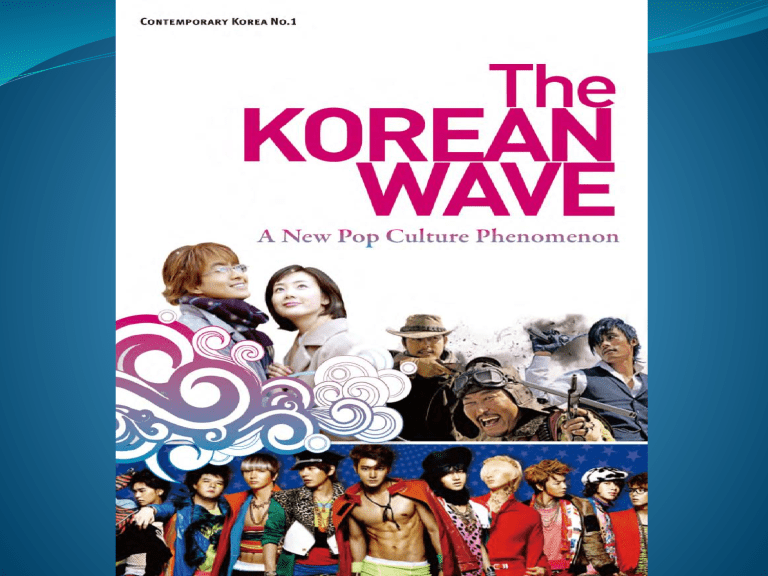
Content 1. Introduction 2. Korean Wave 3. Gangnam Style 4. Controversial Issues 5. Impact of the Korean Wave 6. Conclusion 7. Questions 8. Works Cited Introduction The Korean wave (Hallyu) refers to the pop culture phenomenon that arose during the 1990’s (H.O.T. BOA, etc.) The Korean wave is an umbrella term that is associated with the rising worldwide popularity in South Korean music, movies, and television. Over 40 countries such as China, Japan, Taiwan, Indonesia, United States, etc. Korean Wave The Korean film industry first gained international attention with the 1999 film Shiri. The film was a big budget blockbuster hit worldwide. In 2004, the film Oldboy directed by Chan-wook Park won many awards at the Cannes Film festival. “Savage yet Cool” Korean Wave (continued) “Korean Wave” (1990’s) with the emergence of K-Pop Stars, Cinema, and the demand for South Korean Popular Culture. Turbo Capitalism- Rapid mobilization of the masses to work vigorously in order to achieve great economic gain leading towards modernization. Shows how the industry rapidly adopts global popular cultural elements and styles to appeal to wider audiences. Diversity + Hybridity = success in the various global markets. Industrialization- U.S. Aid and Western Model (Globalization) New rich (Middle Class) emerges in Asia. Mugukjeok- Hybridization Korean Wave (continued) New Consumer Market for Korean Pop Culture Redefining masculinity to gain wider audience (Trans pop- consumerism) Wen Masculinity, Seonbi Masculinity, Soft Masculinity Winter Sonata, Yonsama (BYJ) Bi, Transcultural figure (Singaporean Success) Gangnam Style Gangnam style as of yesterday has 891,972,349 views on YouTube. Psy’s video portrays himself as an important and wealthy man in Gangnam His clownish acts are misrepresentations of an actual Gangnam man Controversial Issues South Korean Cultural Imperialism – “Anti-Hallyu Movement” Impact of the Korean Wave Tourism Consumer Culture Language Boost economy Conclusion The Korean Wave has not only changed the hegemonic masculinity periodically over time due to globalization, but it has also created a new versatile masculinity where Seonbi masculinity (SoftMasculinity) is seen to exemplify a man who strives for achievement. Questions Is Korea losing it’s cultural identity? Do you think Korean culture will successfully find its way to the United States? Do you think Korean masculinity is feminine compared to the United States? Works Cited Page CNN, Lara Farrar for. "'Korean Wave' of pop culture sweeps across Asia - Page 2 - CNN." Featured Articles from CNN. N.p., n.d. Web. 6 Dec. 2012. Jinseob, eon. "My Dear Korea: KOREAN MUSIC: PSY’s “Gangnam Style” and "Gangnam Oppa" in “Architecture 101” (1)."My Dear Korea. ONSEMIRO, 9 Aug. 2012. Web. 6 Dec. 2012. Jung, Sun. Korean masculinities and transcultural consumption: Yonsama, Rain, Oldboy, K-Pop idols. Hong Kong: Hong Kong University Press, 2011. Print. "Hallyu Faces Turning Point-The Korea Herald." Hallyu Faces Turning PointThe Korea Herald. N.p., n.d. Web. 06 Dec. 2012. "Thanks to 'Korean Wave', Korea Expects More Tourists - The Toonari Post News, Powered by the People!" The Toonari Post News Powered by the People Thanks to Korean Wave Korea Expects More Tourists Comments. N.p., n.d. Web. 06 Dec. 2012. "Website Title." 6000 People at Anti-Hallyu Protest against Fuji TV. N.p., n.d. Web. 06 Dec. 2012.
